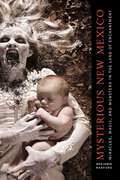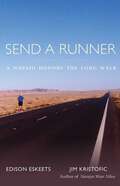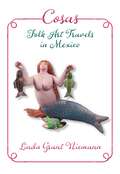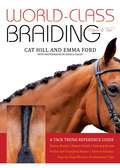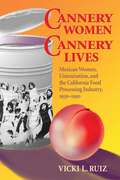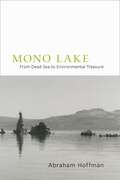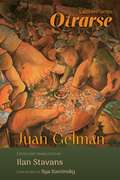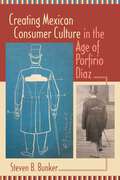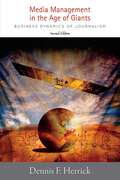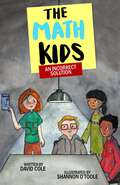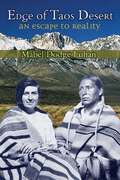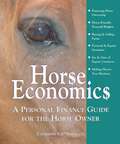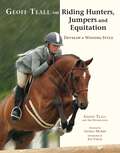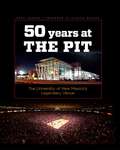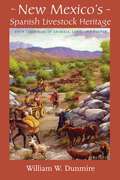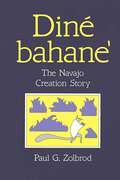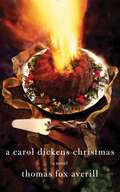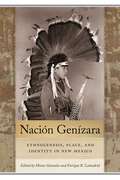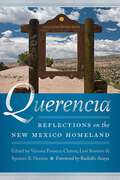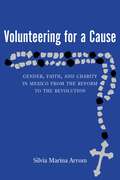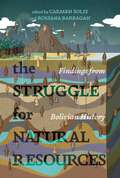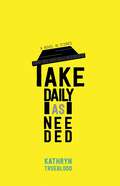- Table View
- List View
Mysterious New Mexico: Miracles, Magic, and Monsters in the Land of Enchantment
by Benjamin RadfordNew Mexico&’s twin traditions of the scientific and the supernatural meet for the first time in this long-overdue book by a journalist known for investigating the unexplained. Strange tales of ghosts, monsters, miracles, lost treasure, UFOs, and much more can be found not far from the birthplace of the atomic bomb. Huge radio astronomy dishes search desert skies for alien life, and the world&’s first spaceport can be found in this enchanted land; in many ways New Mexico truly is a portal to other worlds.Mysterious New Mexico is the first book to apply scientific investigation methods to explain some of New Mexico&’s most bizarre lore and legends. Using folklore, sociology, history, psychology, and forensic science—as well as good old-fashioned detective work—Radford reveals the truths and myths behind New Mexico&’s greatest mysteries.
Send a Runner: A Navajo Honors the Long Walk
by Jim Kristofic Edison EskeetsThe Navajo tribe, the Diné, are the largest tribe in the United States and live across the American Southwest. But over a century ago, they were nearly wiped out by the Long Walk, a forced removal of most of the Diné people to a military-controlled reservation in New Mexico. The summer of 2018 marked the 150th anniversary of the Navajos' return to their homelands. One Navajo family and their community decided to honor that return. Edison Eskeets and his family organized a ceremonial run from Spider Rock in Canyon de Chelly, Arizona, to Santa Fé, New Mexico, in order to deliver a message and to honor the survivors of the Long Walk.Both exhilarating and punishing, Send A Runner tells the story of a Navajo family using the power of running to honor their ancestors and the power of history to explain why the Long Walk happened. From these forces, they might also seek the vision of how the Diné—their people—will have a future.
Cosas: Folk Art Travels in Mexico
by Linda Grant NiemannLove and friendship, art and craft, language and culture are the subjects of this look back at one woman&’s experiences in Mexico over a period of twenty years.What first propels Linda Grant Niemann south are the migrants she encounters in her job as a railroad brakeman in the Southwest. She decides to learn Spanish, and in Mexico she soon meets some surprising kindred spirits. An admirer of craft and expertise, Niemann seeks out individual artists who make exquisite things—Otomi papermakers, the families who produce the famous ceramics of Mata Ortiz, the man in Michoacán who knows how to fashion full-size jaguar thrones in bent cane.Some of her searches lead her to tiny villages and to artists who seldom get to meet their own fans. Niemann wonders if she is experiencing an ordinary shopaholic&’s obsession or if this is something more. The something more reveals itself as the connection of one artist to another.
World-Class Braiding Manes & Tails
by Emma Ford Cat HillA handy quick-reference with step-by-step color photos and easy-to-follow instructions from two top professional grooms.Braiding a horse&’s mane kind of comes with the territory—who can resist playing with all that hair? While it may begin as a downtime activity on a rainy afternoon or fun with friends after riding lessons, braiding takes on a life of its own when it comes to competition. Professional grooms and others who braid on the show circuit can make a living doing just that when they have the skills to do it fast and do it well.Professional grooms Cat Hill and Emma Ford, co-authors of the bestsellingWorld-Class Grooming for Horses,have braided thousands of horses for a variety of disciplines over the course of their esteemed careers in the equestrian industry. Now they&’ve highlighted those skills in a book conceived to be a helpful barn companion—one you can take with you and keep in your tack trunk, providing a go-to reference whenever you need it. Chock full of full-color photographs that illustrate every step of the process, readers learn techniques for:Braiding down—a nice, tight, smooth braid is the key to a sophisticated finish.Using thread, yarn, or rubber bands.Properly finishing and removing braids to avoid hair damage.Button braids two ways.Hunter braids.Running braids.Unpulled manes and long manes.Braiding forelocks.With their expertise, top-tier standards, and trademark clarity as professionals who have made teaching their trade an integral part of their lives, Hill and Ford provide everything you need to know to turn a horse out with professional polish, ready to impress the judges and wow the crowds.
Mavericks
by Jack Schaefer&“Old Jake Hanlon sits on the edge of the mesa and looks out over miles of southwestern plain,&” starts Jack Schaefer&’s all-ages novel Mavericks. Old Jake Hanlon is &“ancient and craglike, weathered and withered . . . something like a worn rocky butte himself.&” Living in his memories, Hanlon prefers to reflect on his youth, when he lived every cowboy&’s dream, rather than think about the old man he has become, now labeled &“a decrepit old nuisance&” by the folks in town. Ultimately, it is Old Jake&’s recollection of the tales of his past—stories of endurance, strength, compassion, and cunning—that helps prepare him for death.
Cannery Women, Cannery Lives: Mexican Women, Unionization, and the California Food Processing Industry, 1930-1950
by Vicki L. RuizWomen have been the mainstay of the grueling, seasonal canning industry for over a century. This book is their collective biography--a history of their family and work lives, and of their union. Out of the labor militancy of the 1930s emerged the United Cannery, Agricultural, Packing, and Allied Workers of America (UCAPAWA). Quickly it became the seventh largest CIO affiliate and a rare success story of women in unions.Thousands of Mexican and Mexican-American women working in canneries in southern California established effective, democratic trade union locals run by local members. These rank-and-file activists skillfully managed union affairs, including negotiating such benefits as maternity leave, company-provided day care, and paid vacations--in some cases better benefits than they enjoy today. But by 1951, UCAPAWA lay in ruins--a victim of red baiting in the McCarthy era and of brutal takeover tactics by the International Brotherhood of Teamsters.
Mono Lake: From Dead Sea to Environmental Treasure
by Abraham HoffmanMono Lake is one of the largest lakes in California, and Californians have been using it, enjoying it, and abusing it since nomadic northern Paiutes began hunting the lake&’s vast bird populations. Controversy between environmentalists and the City of Los Angeles brought so much attention to Mono Lake in the late twentieth century that it became best known for its appearance on &“Save Mono Lake&” bumper stickers. This thoughtful study is the first book to explore the lake&’s environmental and cultural history.Hoffman writes about gold mining in the Mono Basin; the taking of birds and their eggs to supply food for miners and townspeople; a failed oil boom; efforts to develop recreational activities such as a state-operated marina, which also failed; catastrophes including plane crashes and the testing of bombs underwater; and litigation over the diversion of creeks flowing into the lake and the resulting decline in the lake level. A variety of photographs, some never before published, ranging from mining to motor boat races in the 1930s are also included.
Otrarse: Ladino Poems (Jewish Latin America Series)
by Juan GelmanOne of Latin American’s most important poets of the twentieth century, Juan Gelman (1930–2014) spent much of his life in exile from his native Argentina during the Dirty War. Gelman was a child of Yiddish-speaking Ukrainian immigrants, and a significant, seldom recognized portion of his poetry dealt with Jewish themes. He established a dialogue across time with Santa Teresa de Ávila and San Juan de la Cruz, the sixteenth-century Spanish mystical poets whose ancestry was also Jewish. He rewrote portions of the Bible, medieval Hebrew poetry, and even taught himself Ladino, the language of Sephardic Jews, and wrote a book of poems in it.In this bilingual volume, celebrated scholar Ilan Stavans retraces Gelman’s regard for these poetic ancestors, translating into English his Jewish oeuvre by carefully preserving the Hebrew, Spanish, and Ladino echoes of the originals. The result is historically accurate and artistically exhilarating, repositioning Gelman as a major Jewish writer of the last century.
No More Bingo, Comadre!: Stories
by Nasario GarcíaIt takes all kinds to populate Northern New Mexico, and this book has every one: from gypsies and gamblers to ranchers and criminals. Noted author Nasario García introduces us to some of these people and the challenges they face. The title character, Adelfa, flirts with the glamour of casinos and finds herself addicted to gambling. Sam &“Spam&” Austin, an inmate serving a long sentence for murder, is paroled, attends medical school, and becomes a doctor. The affable grandfather in &“Yo Quiero Hacer un Lie &’Way,&” a hard-working and honorable rancher, stuns the proprietor of a mortuary with his request to put a coffin on layaway.
Creating Mexican Consumer Culture in the Age of Porfirio Díaz
by Steven B. BunkerIn Gabriel García Márquez&’s novel One Hundred Years of Solitude, a character articulates the fascination goods, technology, and modernity held for many Latin Americans in the early twentieth century when he declares that &“incredible things are happening in this world.&” The modernity he marvels over is the new availability of cheap and useful goods. Steven Bunker&’s study shows how goods and consumption embodied modernity in the time of Porfirio Díaz, how they provided proof to Mexicans that &“incredible things are happening in this world.&”In urban areas, and especially Mexico City, being a consumer increasingly defined what it meant to be Mexican. In an effort to reconstruct everyday life in Porfirian Mexico, Bunker surveys the institutions and discourses of consumption and explores how individuals and groups used the goods, practices, and spaces of urban consumer culture to construct meaning and identities in the rapidly evolving social and physical landscape of the capital city and beyond. Through case studies of tobacco marketing, department stores, advertising, shoplifting, and a famous jewelry robbery and homicide, he provides a colorful walking tour of daily life in Porfirian Mexico City. Emphasizing the widespread participation in this consumer culture, Bunker&’s work overturns conventional wisdom that only the middle and upper classes participated in this culture.
Media Management in the Age of Giants: Business Dynamics of Journalism, Second Edition.
by Dennis F. HerrickThe emergence of giant media corporations has created a new era in mass communications. The world of media giants—with a focus on the bottom line—makes awareness of business and financial issues critical for everyone in the industry. This timely new edition of a popular and successful textbook introduces basic business concepts, terminology, history, and management theories in the context of contemporary events. It includes up-to-date information on technology and addresses the major problem facing media companies today: How can the news regain profitability in the digital age?Focusing on newspaper, television, and radio companies, Herrick fills his book with real-life examples, interviews with media managers, and case studies. In a time when all the rules are changing because of digital technology, conglomeration, and shifting consumer habits, this text is a vital tool for students and working journalists.
An Incorrect Solution: The Math Kids (Book 5) (The Math Kids)
by David ColeFifth grade is off to a terrible start for the Math Kids. Jordan and Justin are in a different class from Stephanie and Catherine. Worse, they have Miller the Killer for math, and he hates math! Even more troubling, Jordan witnesses Robbie, the class bully, in an angry confrontation with his father and wonders if Constable Colson might be doing more than yelling. People problems suddenly seem a lot more challenging than homework, but maybe with the right plan—and some math—the four Math Kids can find a way to deal with their classroom woes and make sure Robbie stays safe. The Math Kids: An Incorrect Solution is the fifth book in the Math Kids series.
Edge of Taos Desert: An Escape to Reality
by Mabel Dodge LuhanIn 1917 Mabel Sterne, patron of the arts and spokeswoman for the New York avant-garde, came to the Southwest seeking a new life. This autobiographical account, long out-of-print, of her first few months in New Mexico is a remarkable description of an Easterner's journey to the American West. It is also a great story of personal and philosophical transformation. The geography of New Mexico and the culture of the Pueblo Indians opened a new world for Mabel. She settled in Taos immediately and lived there the rest of her life. Much of this book describes her growing fascination with Antonio Luhan of Taos Pueblo, whom she subsequently married. Her descriptions of the appeal of primitive New Mexico to a world-weary New Yorker are still fresh and moving. "I finished it in a state of amazed revelation . . . it is so beautifully compact and consistent. . . . It is going to help many another woman and man to 'take life with the talons' and carry it high."--Ansel Adams
Horse Economics
by Catherine E O'BrienMost horse owners don't have unlimited disposable income, and, unfortunately, equine-related financial decisions are often driven by their passion rather than sound, long-range planning. Here, the author explains how this potentially disastrous scenario can be avoided with the appropriate preparation. Horse Economics helps illustrate a complete financial picture for the horse owner, first by determining the true costs of horse ownership, and then incorporating these added expenses into a household budget. Chapters include information on managing credit, debt, retirement, and investment, as well as an extensive examination of purchasing, owning, maintaining, and selling horse property. The book also includes helpful worksheets for calculating net worth, cash flow, and more.
Geoff Teall on Riding Hunters, Jumpers and Equitation
by Geoff TeallA top trainer teaches you how to perfect a winning position, both on the flat and over fences.Discover how to increase the effectiveness of the time you spend in the saddle, whether you are a beginning hunt seat rider or a seasoned competitor. Geoff? Teall—noted judge, trainer, and clinician—helps you put together an unbeatable package, including:Setting riding goals.Finding the right horse and instructor.Developing confidence and facing your fears.Dressing for success in and out of the show ring.Geoff then demystifies the jumping course, showing you how even the most challenging, demanding patterns can be simplified and easily practiced at home. You&’ll discover the secrets of:Walking any course.Seeing distances.Single jumps and straight lines.Jumping from a turn.Angled jumps and end jumps.Combinations, in-and-outs, and more!Whether the first step on the road to a medal, or a tool to revitalize an experienced rider&’s passion for the sport,Geoff Teall on Riding Hunters, Jumpers and Equitationwill help put the pieces together for that perfect, polished round.
Fifty Years at the Pit: The University of New Mexico's Legendary Venue
by Gary HerronBasketball fans at the University of New Mexico have always been loyal, loud, and numerous, and the devotees have grown in number over the fifty years since the opening of the University Arena, a.k.a. the Pit, in 1966. Herron recounts many of the best players and games in this celebration of one of the best-known facilities in the United States.With almost two hundred color photographs, this illustrative explosion shows you the players, the plays, the coaches, and the sold-out crowds dressed in red. You can recall the colorful nicknames: Petie Gibson, Marvin &“Automatic&” Johnson, and, of course, &“Stormin&’ Norman&” Ellenberger. This stunning work also contains extensive statistics that will not disappoint—like who took the Lobos to the most postseason contests.Herron does not overlook women&’s basketball, a standout sport at UNM, nor does he omit the great non-UNM entertainment that has happened at the Pit: the NMAA state high school basketball tournament, the Gathering of Nations, boxing matches, bull riding, concerts, and more.
New Mexico's Spanish Livestock Heritage: Four Centuries of Animals, Land, and People
by William W. DunmireThe Spanish introduced European livestock to the New World—not only cattle and horses but also mules, donkeys, sheep, goats, pigs, and poultry. This survey of the history of domestic livestock in New Mexico is the first of its kind, going beyond cowboy culture to examine the ways Spaniards, Indians, and Anglos used animals and how those uses affected the region&’s landscapes and cultures.The author has mined the observations of travelers and the work of earlier historians and other scholars to provide a history of livestock in New Mexico from 1540 to the present. He includes general background on animal domestication in the Old World and the New during pre-Columbian times, along with specific information on each of the six livestock species brought to New Mexico by the early Spanish colonists. Separate chapters deal with the impacts of Spanish livestock on the state&’s native population and upon the land itself, and a final chapter explains New Mexico&’s place in the larger American livestock scene.
Diné Bahane': The Navajo Creation Story
by Paul G. ZolbrodThis is the most complete version of the Navajo creation story to appear in English since Washington Matthews' Navajo Legends of 1847. Zolbrod's new translation renders the power and delicacy of the oral storytelling performance on the page through a poetic idiom appropriate to the Navajo oral tradition.Zolbrod's book offers the general reader a vivid introduction to Navajo culture. For students of literature this book proposes a new way of looking at our literary heritage.
A Carol Dickens Christmas: A Novel
by Thomas Fox AverillIt&’s Christmas, and Carol Dickens&’s life is in major transition. Her son Finn, a talented trumpet player, is about to leave for college. Her ex-husband, a real-estate wheeler-dealer, wants to sell their properties in Kansas and move to Arizona. Her wheelchair-bound friend, Laurence, has fallen in love with her. To top it all off, Scraps, the family dog, is dying. As her world spins out of control, Carol seeks refuge in her research on the use of the semicolon—and in her ritual of cooking the perfect series of Victorian holiday meals inspired by A Christmas Carol.
Nación Genízara: Ethnogenesis, Place, and Identity in New Mexico (Querencias Series)
by Moises Gonzales and Enrique R. LamadridNación Genízara examines the history, cultural evolution, and survival of the Genízaro people. The contributors to this volume cover topics including ethnogenesis, slavery, settlements, poetics, religion, gender, family history, and mestizo genetics. Fray Angélico Chávez defined Genízaro as the ethnic term given to indigenous people of mixed tribal origins living among the Hispano population in Spanish fashion. They entered colonial society as captives taken during wars with Utes, Apaches, Comanches, Kiowas, Navajos, and Pawnees. Genízaros comprised a third of the population by 1800. Many assimilated into Hispano and Pueblo society, but others in the land-grant communities maintained their identity through ritual, self-government, and kinship.Today the persistence of Genízaro identity blurs the lines of distinction between Native and Hispanic frameworks of race and cultural affiliation. This is the first study to focus exclusively on the detribalized Native experience of the Genízaro in New Mexico.
Querencia: Reflections on the New Mexico Homeland (Querencias Series)
by Vanessa Fonseca-Chávez, Levi Romero, and Spencer R. HerreraNew Mexico cultural envoy Juan Estevan Arellano, to whom this work is dedicated, writes that querencia &“is that which gives us a sense of place, that which anchors us to the land, that which makes us a unique people, for it implies a deeply rooted knowledge of place, and for that reason we respect it as our home.&”This sentiment is echoed in the foreword by Rudolfo Anaya, in which he writes that &“querencia is love of home, love of place.&” This collection of both deeply personal reflections and carefully researched studies explores the New Mexico homeland through the experiences and perspectives of Chicanx and indigenous/Genízaro writers and scholars from across the state. The importance of querencia for each contributor is apparent in their work and their ongoing studies, which have roots in the culture, history, literature, and popular media of New Mexico. Be inspired and enlightened by these essays and discover the history and belonging that is querencia.
Volunteering for a Cause: Gender, Faith, and Charity in Mexico from the Reform to the Revolution
by Silvia Marina ArromThis thoughtful study challenges a number of widespread assumptions about the role of Catholicism in Mexican history by examining two related Catholic charities: the male Society of St. Vincent de Paul and the Ladies of Charity of St. Vincent de Paul. With thousands of volunteers, these lay groups not only survived the liberal reforms of the mid-nineteenth century but thrived, offering educational, medical, and other services to hundreds of thousands of poor people.Arrom stresses the prominence of women among the volunteers, showing the many ways that Catholicism promoted Mexican modernization rather than being an obstacle to it. Moreover, by reinserting religion into public life, these organizations defied the secularizing policies of the Mexican government. By comparing the male and female organizations collectively, the work shows that the relationship between gender, faith, and charity was much more complicated than is usually believed, with devout men and women supporting the Catholic project in complementary ways.
The Struggle for Natural Resources: Findings from Bolivian History (Diálogos Series)
by Carmen Soliz and Rossana BarragánThe Struggle for Natural Resources traces the troubled history of Bolivia's land and commodity disputes across five centuries, combining local, regional, national, and transnational scales. Enriched by the extractivism and commodity frontiers approaches to world history, the book treats Bolivia's political struggles over natural resources as long-term processes that outlast immediate political events. Exploration of the Bolivian case invites dialogue and comparison with other parts of the world, particularly regions and countries of the so-called Global South.The book begins by examining three Bolivian resources at the center of political dispute since the early colonial period, namely land, water, and minerals. Carmen Soliz, Rossana Barragán, and Sarah Hines show that, as in the colonial and early republican past, these resources have remained the focus of political contention to the present day. Until the end of the nineteenth century, Bolivia's battle over natural resources was primarily concentrated in the highlands and inter-Andean valleys. Beginning in the 1860s, the bicycle and soon the automobile industries triggered demand for natural rubber found in the heart of the Amazon. José Orsag analyzes the impact of this extractive economy at the turn of the twentieth century. The book concludes by examining two resources that are central to understanding the last century of Bolivia's history. Kevin Young examines the fraught business of hydrocarbons, and Thomas Grisaffi analyzes the coca/cocaine circuit. Each chapter studies the social dynamics and political conflicts that shaped the processes of extraction, exchange, and ownership of each of these resources
New Mexico Water and the Environment in 2050
by Laura Paskus Adrian OglesbyThe land, water, and air that make New Mexico a Land of Enchantment are facing increasing threats due to drought, climate change, and declining environmental quality protections. In this E-short edition from New Mexico 2050, noted environmental journalist Laura Paskus and Adrian Oglesby, a water law and water management expert, demonstrate how, in the face of such challenges, citizens can preserve and enrich New Mexico&’s natural resources.
Take Daily as Needed: A Novel in Stories
by Kathryn TruebloodMaeve Beaufort&’s family is messy and complicated, rife with competing demands, difficult compromises, and on-the-spot judgment calls. She is the single mother of Noelle, who has anaphylactic reactions to nuts, and Norm, a nonconformist child whom everyone wants to diagnose. Her father is spending his retirement on high-ticket items he doesn&’t need, her children&’s teachers are suggesting medication, and her mood-swinging mother is threatening to move in. Newly diagnosed herself with Crohn&’s disease, Maeve feels as though she is failing herself, her parents, and her children. But with spirit and determination—and a healthy dose of survival humor—she gives it her best go. Anyone who has ever felt overwhelmed, underappreciated, underpaid, and underwater will find a kindred spirit in Maeve.
